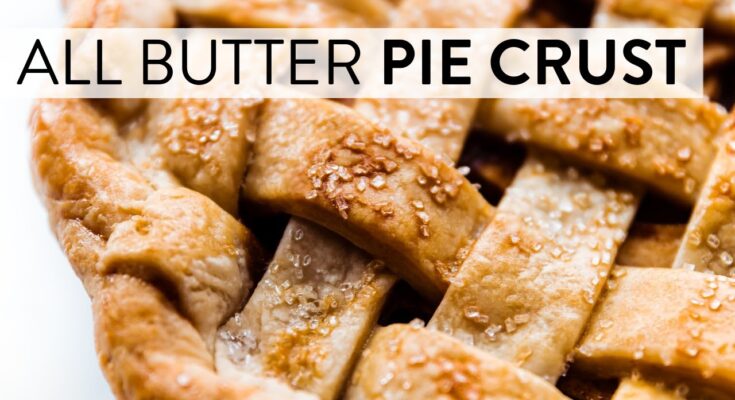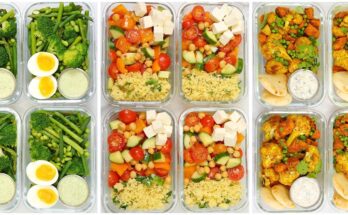Butter Pie Crust Recipe: Let’s be honest—there’s something magical about a golden, flaky pie crust that shatters slightly under the fork and melts in your mouth. And if you’re anything like most home bakers, you’ve probably wondered why some pie crusts taste like cardboard while others make you want to lick the plate. The secret? It’s all about the fat. And when it comes to flavor, nothing beats butter.
Butter-based pie crusts have a reputation for being tricky, but they’re worth every bit of effort. Unlike shortening or lard, butter gives your crust a rich, unbeatable flavor that enhances both sweet and savory pies. The high water content in butter also creates steam during baking, which contributes to that irresistible flakiness. So, whether you’re making a classic apple pie, a savory quiche, or a festive tart, mastering a butter crust is a game changer.
In this guide, you’ll get a foolproof, step-by-step breakdown that demystifies the butter pie crust process. Even if you’ve struggled before, you’ll walk away with the confidence to bake a crust that’s not only beautiful but absolutely delicious.
Ingredients for a Classic Butter Pie Crust
Before you roll up your sleeves, let’s talk ingredients. A perfect pie crust doesn’t need a long grocery list. In fact, simplicity is the name of the game here. But don’t let that fool you—each ingredient plays a vital role.
Essential Ingredients:
- 2 ½ cups all-purpose flour – Gives the crust structure. Look for unbleached flour for a better texture.
- 1 cup (2 sticks) unsalted butter, cold and cut into cubes – The star of the show. Cold butter = flaky layers.
- ½ teaspoon salt – Enhances the flavor.
- 1 teaspoon sugar (optional for sweet pies) – Adds a touch of sweetness.
- 6 to 8 tablespoons ice water – Helps the dough come together without becoming sticky.
Ingredient Tips:
- Butter: Choose high-quality unsalted butter with a high fat content (like European-style butters). The flavor and flakiness really shine through.
- Flour: Stick with all-purpose flour unless you’re experienced with pastry flour, which can be a little more delicate.
- Water: Use ice water. Not cold tap water—ice water. It makes a difference in keeping everything chilled while mixing.
These basic ingredients might look simple, but they’re the building blocks of something incredible. The key to pie crust success lies in how you handle them—and we’ll get into that next.
Tools You’ll Need
Just like a carpenter needs good tools, a baker benefits from having the right gear on hand. While you don’t need fancy gadgets to make a pie crust, having the right tools can make the process smoother and more enjoyable.
Must-Have Tools:
- Mixing bowls – One large for mixing and one small for water.
- Measuring cups and spoons – Accuracy matters here.
- Pastry cutter or forks – To cut the butter into the flour. Alternatively, use your fingers if you’re confident.
- Rolling pin – A smooth, solid rolling pin is essential for even thickness.
- Plastic wrap or parchment paper – For wrapping and chilling the dough.
- Pie dish – Glass or metal dishes work best; avoid ceramic unless you know how it conducts heat.
Nice-to-Have (but not essential):
- Food processor – Great for quick, even butter cutting, but be careful not to overprocess.
- Bench scraper – Handy for gathering dough and keeping surfaces clean.
- Pie weights or dried beans – For blind baking, especially with pre-baked crusts.
Having your tools prepped before starting means less stress and more fun. Think of it like setting the stage for your pie to shine.
Step-by-Step Instructions to Make Butter Pie Crust
Now that you’ve got your ingredients and tools ready, it’s time to dive into the process. Making pie crust might feel intimidating at first, but follow these steps, and you’ll be well on your way to crust perfection.
Step 1 – Measure and Chill Your Ingredients
This step is all about prep. First, measure out your flour, salt, and sugar into a large mixing bowl. Then cube your butter and pop it into the freezer for 5-10 minutes. You want that butter ice cold. The colder the butter, the more likely it is to stay in chunks as you mix—which is what gives you those dreamy, flaky layers.
Pro tip: Even your bowl and utensils can go into the fridge for a quick chill. It may sound extra, but in warm kitchens, every little bit helps keep things cool.
You should also prep your water at this stage. Fill a small bowl with ice, add water, and let it sit. You’ll only need a few tablespoons, but chilling it properly now means it’s ready when you are.
Step 2 – Combine Dry Ingredients
Once your ingredients are chilled and ready to go, it’s time to get mixing. In a large bowl, combine your flour, salt, and sugar (if using). Give it a quick whisk or stir with a fork. This might seem simple, but even distribution of the salt and sugar is important so that your dough is consistently seasoned throughout.
Why is this step crucial? Well, if the salt or sugar isn’t evenly distributed, some bites of your pie might taste off. It’s all about creating a balanced flavor foundation before you add the star ingredient—butter.
Now, if you’re using a food processor, pulse the dry ingredients a couple of times just to blend them. Be careful not to go overboard—think of this as “waking up” the flour. You’re not trying to create friction or heat, just getting things ready for the butter.
This sets the stage for the most important texture-building step of all: cutting in the butter.
Step 3 – Cut in the Butter
Now we’re getting to the good stuff. Grab your pastry cutter, two forks, or even your hands (if they’re cold), and add the chilled butter cubes to your flour mixture. The goal here is to coat the butter pieces in flour and break them down into small chunks—think pea-sized bits or slightly larger.
These chunks are crucial. Why? Because they melt during baking, releasing steam and forming pockets of air that turn into those flaky layers we crave in a good crust. If the butter melts into the flour too early, your crust will be dense and tough instead of light and airy.
If using your fingers, work quickly. Pinch the butter into the flour with your fingertips, not your palms (which are warmer). A few larger chunks are okay—they actually help with flakiness and give the crust some rustic charm.
If using a food processor, pulse just until the butter looks like coarse meal with some larger pieces. Stop as soon as you hit that texture. Over-processing is a sure way to end up with a greasy, tough dough.
Step 4 – Add Water Gradually
This is where the dough starts to come together—but here’s the trick: less is more. Start by adding 1 tablespoon of your ice-cold water and gently toss the mixture with a fork or your hands. Keep adding water one tablespoon at a time, mixing gently after each addition.
You’re not trying to hydrate the dough like bread—you’re just trying to get it to hold together when pressed. Stop as soon as the dough holds its shape when squeezed between your fingers. For most people, this happens around 6 tablespoons, but depending on your flour or the weather, it could be a little more or less.
Here’s the golden rule: the dough should not be wet or sticky. It should be shaggy but cohesive, like wet sand that just holds together. If it looks dry but sticks when pressed, you’re good to go.
This is where patience pays off. Resist the urge to dump in all the water at once. You want control, and adding water slowly gives you just that.
Step 5 – Form and Chill the Dough
Once your dough is holding together, it’s time to form it into discs. Turn the mixture out onto a clean surface and divide it into two equal portions. Gently press and shape each half into a flat disc—don’t knead it or overwork it. This isn’t bread dough. You’re just bringing it together.
Wrap each disc tightly in plastic wrap and refrigerate for at least one hour. This resting time is non-negotiable. It allows the gluten to relax (so your crust won’t shrink) and the butter to firm back up (so your crust will be flaky).
You can chill the dough for up to two days, or freeze it for longer storage. Just make sure it’s tightly wrapped to avoid freezer burn.
After chilling, your dough is ready to roll—literally. And that’s where we’ll head next.
Step 6 – Roll Out the Dough
So, your dough is chilled and ready. This is where your crust starts to take shape—literally. Lightly flour your work surface and rolling pin. Take one of your dough discs out of the fridge and let it rest for about 5 to 10 minutes so it softens just enough to roll without cracking.
Place the dough in the center of your floured surface and begin to roll outward from the center in all directions. Don’t roll back and forth like you’re ironing a shirt—use gentle, even strokes to push the dough outward. Rotate the dough a quarter-turn every few strokes to maintain a circular shape and prevent sticking. Add a sprinkle of flour underneath if it starts to catch.
You’re aiming for a circle about 12 inches in diameter and about 1/8 inch thick. Think about the size of your pie dish—there should be enough overhang to allow for crimping or fluting the edges. The key is even thickness throughout, so the crust cooks uniformly and doesn’t develop soggy spots.
Pro tip: Roll the dough around the rolling pin to transfer it to your pie dish. It’s the easiest way to lift it without tearing. Once you’ve got this step down, you’ll feel like a total baking boss.
Step 7 – Fit into the Pie Pan
Gently unroll your dough over the pie dish and let it settle into the bottom and sides. Don’t stretch it to fit—stretching causes shrinkage during baking. Instead, lift the edges and let the dough fall naturally into the corners. Press it lightly to fit the contours of the dish.
Trim any overhanging dough to about 1 inch past the edge. You can fold this over and crimp it with your fingers or a fork to create a decorative edge. If you’re doing a double crust, now’s the time to fill your pie and repeat the rolling process with the second disc.
Once the crust is fitted and edged, chill it again for at least 30 minutes. Yes, more chilling! But trust me, it’s worth it. This helps firm up the butter and prevents shrinkage in the oven.
Want fancy edges? Use your thumb and forefinger to create a fluted edge, or press with a fork for a rustic vibe. Either way, you’re well on your way to pie perfection.
Step 8 – Blind Bake (if necessary)
Blind baking means pre-baking the crust without filling. It’s necessary for pies with wet or no-bake fillings like custard or cream pies. It keeps the crust from turning into a soggy mess.
Start by lining the chilled crust with parchment paper or foil, then fill it with pie weights, dried beans, or even rice. These keep the crust from puffing up as it bakes. Place the pie pan on a baking sheet and bake at 375°F (190°C) for about 15–20 minutes.
After that, carefully remove the weights and parchment, then return the crust to the oven for another 10–15 minutes, or until golden brown. If the edges are browning too quickly, cover them with foil or a crust shield.
This process gives you a crisp, golden base that holds up beautifully to creamy fillings. And that, my friend, is the secret to a no-sog pie.
Troubleshooting Common Pie Crust Problems
Even the best bakers hit a few bumps in the road. Let’s tackle some common pie crust issues and how to fix them:
1. Dough is too dry: This usually happens when not enough water was added. Try sprinkling in an extra tablespoon of ice water and knead gently just until it holds together.
2. Dough is too sticky: Too much water. Add a bit of flour while rolling it out, but don’t overdo it, or you’ll end up with a tough crust.
3. Crust shrinks while baking: The dough may not have been rested enough. Always chill the dough after fitting it into the pan to relax the gluten.
4. Crust cracks when rolling: This could be from over-chilling or not letting it rest long enough after refrigeration. Let it sit at room temp for a few extra minutes before rolling.
5. Soggy bottom: Blind baking helps, as does brushing the crust with a beaten egg white before adding your filling. This creates a moisture barrier.
Mastering these pitfalls takes a bit of practice, but once you’re familiar with the signs, you’ll troubleshoot like a pro.
Storing and Freezing Pie Crust Dough
One of the best things about homemade butter pie crust is its flexibility—you don’t have to use it all at once. In fact, making pie dough ahead of time is a smart move, especially during the busy holiday season or before big baking projects.
Storing in the Fridge: Once your dough discs are wrapped tightly in plastic wrap, they can be stored in the refrigerator for up to 2 days. Be sure to label the date so you don’t forget. When you’re ready to use it, let it rest at room temperature for about 10 minutes to soften slightly before rolling.
Freezing for Later: Pie dough freezes beautifully. After wrapping in plastic, place each dough disc into a resealable freezer bag for extra protection. You can freeze them for up to 3 months without any loss in quality. To use, just thaw overnight in the refrigerator and then let it sit out for a few minutes before rolling.
Freezing a Rolled-Out Crust: If you really want to get ahead, you can roll out the dough, fit it into a pie dish, and freeze the whole thing (covered tightly in plastic wrap and foil). When it’s time to bake, you can blind bake it straight from the freezer—just add a few extra minutes to the baking time.
Having prepped crusts in your fridge or freezer means you’re always just a few steps away from a delicious homemade pie—without the last-minute scramble.
Butter Pie Crust vs Other Types
There’s more than one way to make a pie crust, but not all fats are created equal. Let’s break down the differences between butter, shortening, and lard-based crusts so you can understand why butter is often the gold standard.
Butter Crust:
- Flavor: Rich, slightly nutty, and downright delicious. Nothing beats the taste of real butter.
- Texture: Flaky and tender when done right.
- Difficulty: Slightly more finicky—requires chilling and careful handling to avoid melting the butter.
Shortening Crust:
- Flavor: Mild, neutral flavor—not bad, but not memorable.
- Texture: Very tender and holds shape well. Easier to work with than butter.
- Difficulty: Easier for beginners, but lacks that buttery taste.
Lard Crust:
- Flavor: Subtle, savory richness. Great for meat pies and savory tarts.
- Texture: Incredibly flaky.
- Difficulty: Somewhere between butter and shortening in ease of use.
Conclusion? If flavor matters most—and let’s face it, it does—butter wins every time. Sure, it might take a bit more patience, but the results are undeniably worth it. Plus, once you’ve nailed the technique, you’ll never want to go back.
Final Thoughts and Pro Tips
Making a butter pie crust might seem intimidating at first, but like anything, it gets easier with practice. Each time you roll out a dough, you’ll learn something new—how your kitchen’s temperature affects butter, how much water your flour needs, how to feel the “just right” consistency in your fingertips.
Here are a few final nuggets of wisdom to take with you:
- Keep everything cold: Butter, water, even your hands if needed.
- Don’t overwork the dough: Less handling = more flakiness.
- Let it rest: Both before and after rolling.
- Practice makes perfect: Even the pros mess up now and then.
And most importantly—have fun with it. Pie baking is as much about joy as it is about technique. So don’t sweat the cracks or imperfections. Every rustic edge and buttery crumble tells the story of something homemade, heartfelt, and totally delicious.
FAQs about Butter Pie Crust Recipe
Q1: Can I use salted butter for pie crust?
Yes, you can—but it’s best to use unsalted butter so you can control the salt level in the dough. Salted butter might throw off the flavor balance.
Q2: Why is my pie crust tough instead of flaky?
This usually happens when you overwork the dough or add too much water. Keep it cold and mix just until it holds together.
Q3: Do I need to chill the dough before rolling?
Absolutely. Chilling the dough (at least 30 minutes) helps relax the gluten and firms up the butter—this leads to a flakier crust.
Q4: Can I freeze butter pie crust?
Yes! Wrap it tightly in plastic wrap and freeze for up to 3 months. Just thaw in the fridge before using.
Q5: What’s the best way to roll out pie crust without it sticking?
Lightly flour your work surface and rolling pin. Rotate the dough often and don’t be shy to dust with a little more flour as needed.
Q6: Is it better to use a food processor or mix by hand?
Both work. A food processor is quicker, but mixing by hand gives you more control and prevents overmixing.
Q7: Can I make this crust vegan?
Yes—swap the butter for vegan butter or chilled coconut oil. Just know the texture may vary slightly.
Q8: How do I prevent soggy bottom crusts?
Blind bake the crust (pre-bake it with weights), especially for wet fillings like custards or fruit pies. Also, brush with egg wash for an extra barrier.
Conclusion
So there you have it—a complete, step-by-step guide to mastering the ultimate butter pie crust. From selecting the right ingredients and tools to chilling, rolling, and blind baking, you’re now equipped with everything you need to create a crust that’s flaky, flavorful, and deeply satisfying.
Whether you’re baking a classic apple pie, a savory quiche, or a decadent chocolate tart, your buttery, handmade crust will take it to the next level. So tie on your apron, flour that countertop, and get rolling—your best-ever pie awaits.



